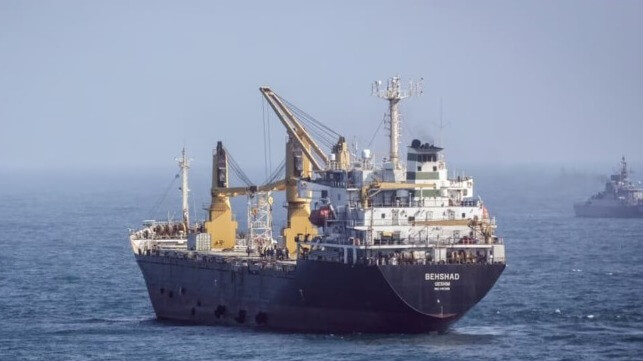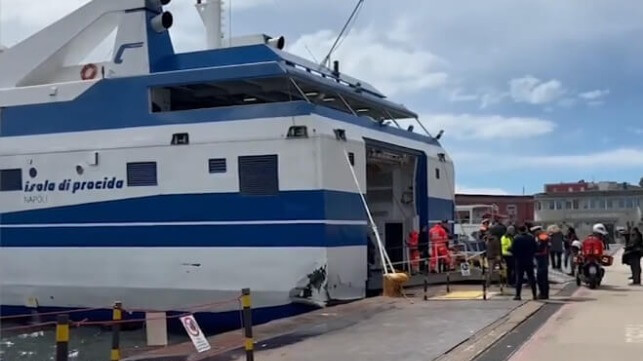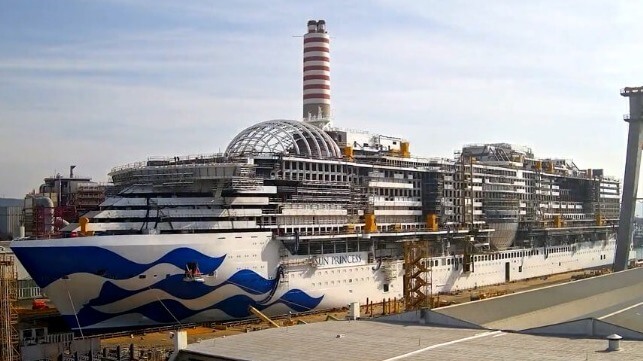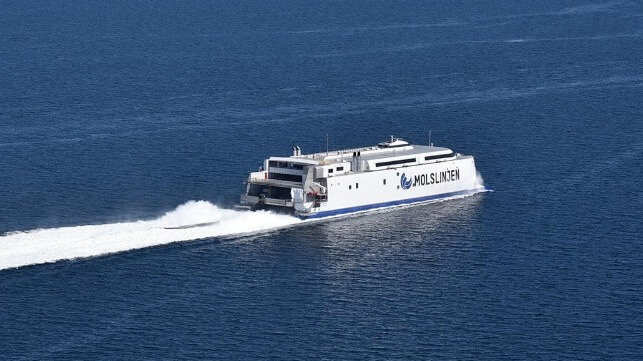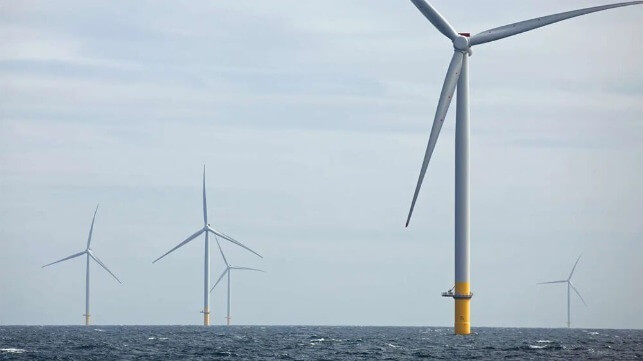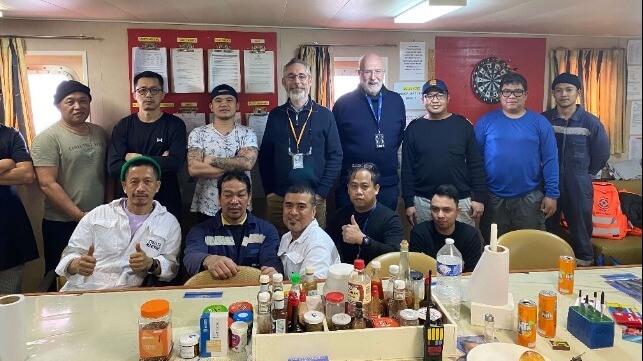Is China Ready to Put Solar Panels Out at Sea?
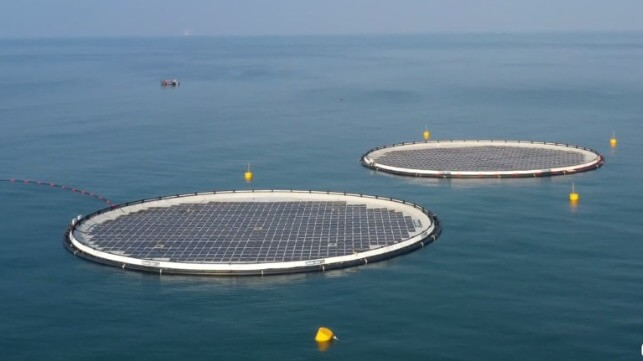
[By You Xiaoying]
China is increasingly seeking to put solar panels on the seas off its coastline, with some state-run companies experimenting as far offshore as 30 kilometers.
A global leader in renewable energy, China has already been looking to the ocean to meet its future power via wind, waves and tides.
But ambitious plans for large solar installations face problems ranging from rough seas to a regulatory vacuum, experts have told Dialogue Earth.
The country’s strong supply chains could give it a leg up in tackling hurdles to ocean solar power. It could spearhead a new sector that harnesses the vast surface of the world’s coastal and offshore waters to generate clean energy, experts say.
An opportunity for coastal regions
Ocean-based solar power is relatively new, with the first deployments dating back less than a decade.
Some of the earliest adopters were Norwegian fish farms. They used solar instead of diesel to power their barges, says Børge Bjørneklett, a Norwegian entrepreneur who invented a floating system in 2016.
His design was inspired by the structure of some fish farms. Rows of solar panels are laid on top of large membranes which float on water and are anchored to the sea floor.
“If it [were] possible to deploy solar farms on near-shore ocean, it would represent almost limitless surface,” says Bjørneklett, who founded the floating solar company Ocean Sun in 2016 and was its CEO until recently.
Traditional solar farms occupy a lot of land. This can be difficult to find close to big cities, and in the countryside it may be needed for agriculture and nature.
Putting solar power “closer to the public” in cities along coasts or by big lakes is the “best application for solar energy”, says Bjørneklett, who believes most solar farms will be situated on water in future.
“The largest interest for floating solar comes from Southeast Asia, China and India – where you have high population density and large solar farms [on land] are in competition with agriculture or urbanisation,” he adds.
Dipping a toe in ocean solar
Last December, China General Nuclear Power Group (CGN) started building an ocean-based solar farm with a capacity of 400 megawatts (MW) in Laizhou Bay off east China’s Shandong province.
The project will see solar panels bolted to posts attached to the bottom of the Bohai Sea in waters between 8.5 and 11 metres deep, according to a press release from CGN. Once complete, the plant is expected to generate 690 gigawatt-hours (GWh) of power annually, the company said.
The sector is still nascent in China though. “Few ocean-based solar power projects have been installed and their capacities are not big,” Xu Honghua, director of Beijing-based thinktank the Chinese Renewable Energy System Association (CRESA), tells Dialogue Earth. “In general, it is still at an experimental phase.”
China added 217 gigawatts (GW) of solar power capacity last year, more than the United States has in its history, according to BloombergNEF.
Only around 3 GW of this was ocean-based, according to estimates by Zhou, a manager at a consulting firm focused on renewable power projects, who asked to be cited by his family name only. But interest is rising.
At present, most of China’s large solar farms are situated in the less-populated north-west of the country. The electricity they generate needs to be transmitted long distances to the big coastal cities of the east and south-east where it is needed. Building ocean-based solar could potentially solve this headache by locating plants close to their end users, reducing costs.
“This also means that provinces that need a lot of electricity would be able to use the natural resources on their doorstep,” says Zhou.
Policy U-turn or plan for growth?
In 2018, some 90% of China’s top 500 energy companies were state-owned, largely because of the importance of the energy industry to the country, an analysis by industry outlet in-en.com found.
Most ocean-based solar developers in China are state-owned companies, some of which are directly supervised by the central government, Xu says. “This is a new sector with large-scale projects, promising economies of scale and great market potential,” Xu adds.
According to Zhou, the companies that have invested the most in ocean solar are those that had acted slowly in other new-energy sectors – such as China National Nuclear Corporation, China Three Gorges Renewables and CGN. “They were a little conservative in investing in renewables previously … so they want to act more vigorously in making plans in upcoming markets,” he says.
But two documents released by the Ministry of Natural Resources in the past few months have sparked discussions over the sector’s future.
In November, the ministry instructed all regional marine authorities to establish a “multi-layer” administrative mechanism to help approve sea area use – not only for solar projects but in general. Just two months later, the ministry’s Department of Sea Area and Island Management ordered all their regional branches to pause the processing of sea-usage applications from ocean-based solar projects, according to PV Time, an industry outlet.
Experts told Dialogue Earth the suspension does not mean that China will not develop ocean-based solar. They believe the central government is trying to lay the groundwork for large-scale projects, especially at the policy level, to ensure their smooth development in the future.
Xu says ocean-based solar “is the trend”. Many government departments and other parties need to coordinate to develop it, he points out. Technical aspects still need research, while proper standards will help avoid some of the pitfalls of past solar projects and prevent “unnecessary losses caused by blind development”.
“For example, in the past, some onshore solar plants were allowed to be built in protected areas, river channels or flood-relief areas without proper permitting procedures or when the industry rules were unclear,” he notes. “They had to be demolished later.”
Zhou agrees that the authority is taking a “cautious” approach to avoid repeating some of the mistakes made early on with onshore solar power. He cites the sun-baked north-western province of Gansu as a cautionary tale.
In the early 2010s, a large number of onshore solar farms were built in Gansu after the central government promoted the development of renewable energy. Rapid growth led to serious headaches when power grids were unable to take in the volume of power generated by the plants, as state-run China Energy News reported in 2015. The result was huge curtailment – or wastage – of excess power.
“There are too many examples in China where companies rushed into one sector at the same time, saturating the market quickly and creating issues,” says Zhou.
The Ministry of Natural Resources seems to want to “utilize resources in a more refined and scientific way,” he adds. “It might also want to control the size of projects to ensure the sector grows steadily.”
Shandong spearheads offshore solar
Although regulations are still being ironed out, China’s central government has encouraged provinces and state-run energy firms to step up research and development.
In a notice released last September, the National Energy Administration (NEA) said it supported the development of pilot projects “in developed sea areas such as salt fields”, meaning special areas used for harvesting sea salt, and highlighted the need to prioritize assessing ecological and environmental impacts.
Some provinces had pounced on the emerging sector as early as 2021.
Ocean-based solar power plays a role in both Jiangsu and Zhejiang’s renewable development plans. The former is planning to build “energy islands” and support the integration of offshore wind, solar and fish farming all in the same patch of water.
Shandong – an industrial, manufacturing and agricultural hub – might be the most ambitious of all. Facing the Yellow Sea to the east and the Bohai Sea to the north, the province has more than 3,000 kilometres of coastline, one-sixth of China’s total.
In 2022, its provincial energy administration set detailed targets that include starting to build 13 GW of solar power capacity fixed to the seabed with posts, and trying to start building 2 GW of floating solar by 2025. By that year, it intends to connect to the grid 11 GW of the former and 1 GW of the latter.
It also announced subsidies for companies that start building floating ocean solar projects between 2023 and 2025. (The central government has ceased giving out financial incentives to solar projects.)
Hu Bo, head of the Shandong Energy Administration, said in February: “It has been proven that ocean-based solar has great developmental potential and high cost-effectiveness, and is eco-friendly, too.”
Some projects are taking solar power even further out to sea. In 2022, the Shandong branch of the State Power Investment Corporation (SPIC) employed Ocean Sun’s technology to build a 500-kilowatt experimental floating solar farm far from the coastal sites favoured by other projects. Situated more than 30 kilometres off the coast of Haiyang, in waters about 30 metres deep, the experiment was designed to test the feasibility of building a 20 MW floating solar project there in the future.
A total of 770 solar panels were laid on top of two circular floating platforms, each 53 metres across, as part of a project that also featured a 300 MW wind farm.
Bjørneklett, the founder of Ocean Sun, describes the Haiyang project as “fantastic” and “exciting”. But he acknowledges its many challenges, such as ocean waves that could be as high as 10 metres.
“This is a very bold and experimental activity,” he adds. “You learn a lot, of course, in that process.”
Footage circulating on the Chinese internet last year purported to show that the membrane and solar panels of one of the project’s platforms had gone missing. An industry expert told Shanghai-based outlet Yicai that the footage had been filmed at the Haiyang project sometime in 2022 and that the missing components had likely sunk in rough seas.
Ocean Sun told Dialogue Earth in March that the Shandong project is a part of the company’s ongoing cooperation on research and development with SPIC, and it is not in a position to comment on the footage.
Hopes and challenges for ocean-based solar
Building floating ocean solar farm is “much more challenging” than onshore construction and once built they face far tougher conditions, including saltwater that corrodes electronics and battering from waves and wind, Bjørneklett points out.
The Norwegian thinks completely offshore floating solar “will probably not happen right away” because it can “easily become too expensive”. A more promising option is to build in semi-sheltered waters, he adds.
Another hurdle is a shortage of experience in the development, design, installation and operation of such projects. Xu, of CRESA, says that China needs to continue accumulating experience and enhance its ability to come up with different designs for different natural conditions and power demands.
In terms of non-technical challenges, the lack of industry regulations is viewed as a roadblock. Standards and policies will need to be established for various aspects, Xu notes, including sea-usage permitting, connection to power grids, environmental assessments and project approval. Coordination between government agencies will also be crucial.
Trade body the China Photovoltaic Industry Association has called for improved standards and a certification system for the sector.
In a report on the status and challenges of ocean-based solar power in China, it said energy, maritime, natural resources, power grid and other relevant authorities should join forces to formulate a template for the overall approval process of marine energy projects and guide companies to develop them.
China’s advanced manufacturing capabilities can give it a boost. Major Chinese solar power manufacturers are already working in the coastal and offshore areas: Sungrow set up a subsidiary for developing floating-solar businesses as early as 2016; Jinko Solar has created double-sided solar panels that can generate power from light reflected off the ocean surface; and JA Solar has unveiled two types of marine solar panels – one for projects fixed to the seabed with posts, and another for those that float.
“China has the largest and most complete industry chain for onshore solar. This can provide it with a large volume of technological experiences and reserves,” Zhou says.
He believes the country is “perfectly capable of” taking its onshore experience out to sea step by step.
You Xiaoying is an award-winning freelance climate journalist living in London. She previously worked as the China editor for Carbon Brief and was the author of Carbon Brief’s China Briefing, which won the Covering Climate Now award in 2022.
This article appears courtesy of Dialogue Earth and may be found in its original form here.
The opinions expressed herein are the author's and not necessarily those of The Maritime Executive.
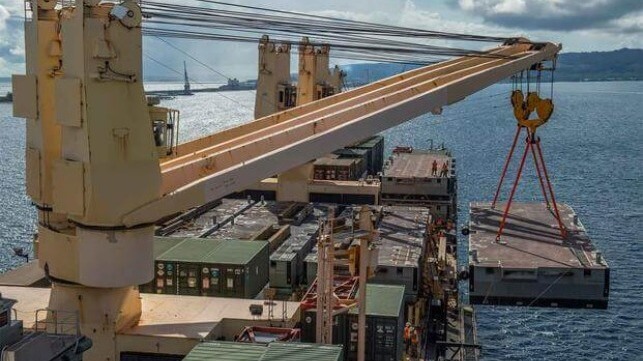
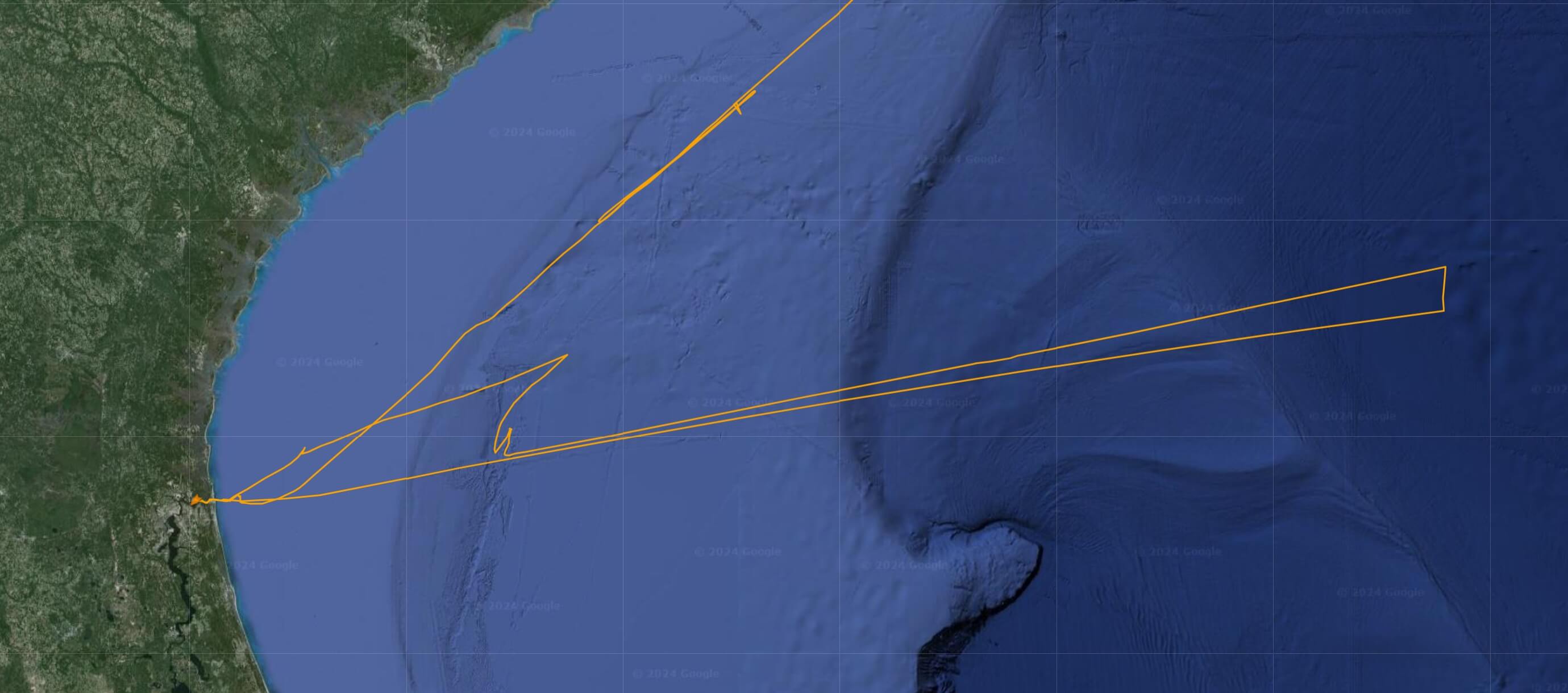 USNS Bobo's trackline: a transit from Norfolk to Jacksonville; east-northeast to cross the Atlantic; back to Jacksonville at a slow bell, with a brief diversion on the return (
USNS Bobo's trackline: a transit from Norfolk to Jacksonville; east-northeast to cross the Atlantic; back to Jacksonville at a slow bell, with a brief diversion on the return (
